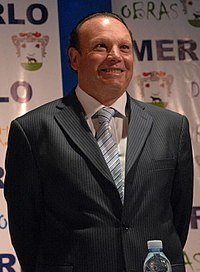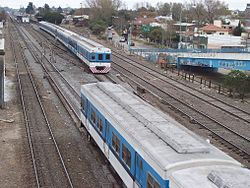
Buenos Aires, officially the Buenos Aires Province, is the largest and most populous Argentine province. It takes its name from the city of Buenos Aires, the capital of the country, which used to be part of the province and the province's capital until it was federalized in 1880. Since then, in spite of bearing the same name, the province does not include Buenos Aires proper, though it does include all other parts of the Greater Buenos Aires metropolitan area. The capital of the province is the city of La Plata, founded in 1882.

Greater Buenos Aires, also known as the Buenos Aires Metropolitan Area, refers to the urban agglomeration comprising the Autonomous City of Buenos Aires and the adjacent 24 partidos (districts) in the Province of Buenos Aires. Thus, it does not constitute a single administrative unit. The conurbation spreads south, west and north of Buenos Aires city. To the east, the River Plate serves as a natural boundary.

Moreno is a city in Buenos Aires Province, Argentina. It is the head town of Moreno Partido. It forms part of the Greater Buenos Aires urban conurbation and is located around 36 km (22 mi) to the west of the autonomous city of Buenos Aires.
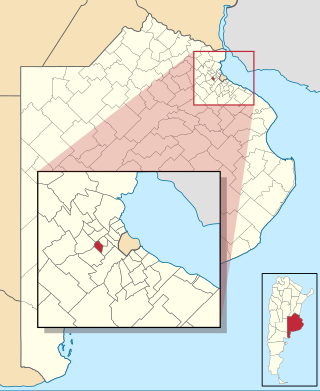
Ituzaingó is a partido of Buenos Aires Province. It is in the Gran Buenos Aires urban area, Argentina, 10 kilometres (6.2 mi) west of Buenos Aires city. It has an area of 38.51 km2 (14.9 sq mi) and a population of 168,419. Its capital, the city of Ituzaingó, and the other districts in Ituzaingó Partido were part of the Morón Partido until 1995.

A partido is the second-level administrative subdivision only in the province of Buenos Aires, Argentina. They are formally considered to be a single administrative unit, usually contain one or more population centers, and are divided into localidades. The subdivision in partidos in Buenos Aires Province is distinct from all other provinces of Argentina, which call their second-level subdivisions departamento and are further subdivided into distinct municipalities.

Morón is a city in the Argentine province of Buenos Aires, capital of the Morón partido, located in the Greater Buenos Aires metropolitan area, at 34°39′S58°37′W. Located 20 km (13 mi) west of Downtown Buenos Aires, Morón is easily reached via bus along Avenida Rivadavia, via National Highway 7, and the Sarmiento railway line.

National Route 9 is a major road in Argentina, which runs from the center-east to the northwest of the country, crossing the provinces of Buenos Aires, Santa Fe, Córdoba, Santiago del Estero, Tucumán, Salta and Jujuy. It starts on Avenida General Paz, which marks the border between the Autonomous City of Buenos Aires and the surrounding province of the same name, and ends at the Horacio Guzmán International Bridge, on the La Quiaca River, traversing 1,967 km (1,222 mi). The road is a limited access motorway from Buenos Aires to Rosario.

Tres de Febrero is a partido of the Greater Buenos Aires conurbation area in the Buenos Aires Province, Argentina.
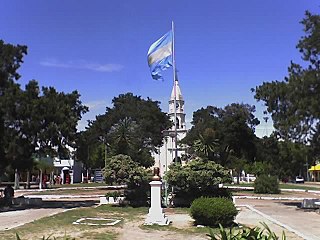
Merlo is the head town of the eponymous partido of Merlo and seat of the municipal government, located in the Greater Buenos Aires urban area of Buenos Aires Province, Argentina.

San Antonio de Padua, or plainly Padua, is a city in the Greater Buenos Aires, in Argentina. It is located in Merlo Partido. The city has an area of 6.25 km2 (2 sq mi) and a population of around 38,000.

Parque San Martín is a city located in Merlo Partido, Buenos Aires Province, Argentina. Parque San Martín was founded around 1948 by real estate promoters, in the estates belonging to the Etcheverry family. Like many others places in Argentina, the city was named after the Argentine independence hero General José de San Martín.
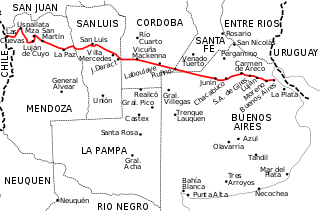
National Route 7 is a road in Argentina. It crosses the country from east to west, from the capital to the border with Chile, thus linking the Atlantic coast with the Andes, crossing the provinces of Buenos Aires, Santa Fe, Córdoba, San Luis and Mendoza. It has a total length of 1,224 km (761 mi), of which 367 km (228 mi) (30%) are freeways.
There are a number of major football rivalries in Argentina.
Libertad is a city located in Merlo Partido, Buenos Aires Province, Argentina. It forms part of the Greater Buenos Aires urban conurbation.

Mariano Acosta is a city located in Merlo Partido, Buenos Aires Province, Argentina. Mariano Acosta was founded by the landholder and businessman Juan Posse in the earliest 20th century, and for years the town was known as Villa (village) Posse. Villa Posse changed its name to Mariano Acosta when the British-owned railway company Buenos Aires Western Railway Co. opens a railway station at its surroundings in 1910. The station was named after Mariano Acosta (1825-1893), Argentine lawyer and politician, former Vice-President of Argentina and governor of Buenos Aires.

Veinte de Junio is a town located 35 km from Buenos Aires, in La Matanza, Buenos Aires Province, Argentina.

Paso del Rey is a city located 35.5 km west of Buenos Aires, in Moreno, Buenos Aires Province, Argentina.

Avenida Rivadavia is one of the principal thoroughfares in Buenos Aires, Argentina, extending 23 miles (37 km) from downtown Buenos Aires to the western suburb of Merlo.
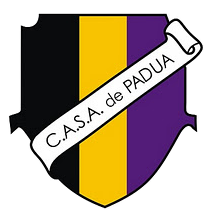
Club Atlético San Antonio de Padua, familiarly known as CASA de Padua, is an Argentine sports club located in the city of San Antonio de Padua, Buenos Aires Province. Although CASA is mostly known for its rugby union team, the club hosts the practise of other sports and activities such as basketball, field hockey, swimming, pilates and yoga.







